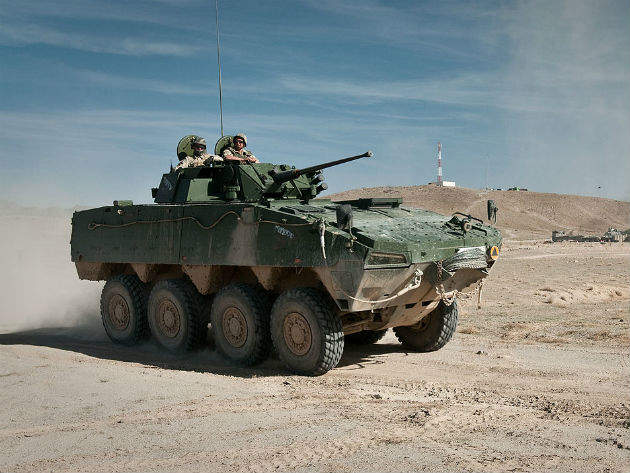
Ever since military vehicles first supplanted horses on the battlefield, their basic drive train has remained essentially unchanged, while at the same time the burgeoning weight of armour and weapons, coupled with growing performance demands, have forced the engines to become larger and the vehicles themselves heavier.
But, by swapping the conventional diesel engine for a diesel generator, and drive shafts, differentials and transmission systems for powerful and compact electric motors that fit entirely within standard 20-inch wheel rims, QinetiQ’s hub-drive significantly reduces platform weight and opens up a range of new possibilities for vehicle design.
Electro-mechanical design
A spokesperson for the company’s Electric Drive business, is the first to admit that hub drives are not a new concept, but although the idea itself is over 100 years old, and the military have been looking at them in earnest since the mid-1980s, they have never quite managed the performance jump necessary to become truly commercially viable. At least not until now.
“Our approach at QinetiQ – our uniqueness – is to take a design approach using a motor and a multi-speed gear box,” said the spokesperson. “Rather than a pure electrical or a pure mechanical solution, we use a multi-speed gearbox in the hub to get a good balance of electro-mechanical design.”
That kind of thinking, he explains, allows them to overcome one of the big problems that has beset previous designs: attempting to cover the total torque speed map, from slow crawl to high speed, with an electric motor alone places high demands not only on the motor itself, but also on the ancillary electronics. QinetiQ’s hybrid approach not only solves that issue, but also brings improved mobility, integral braking and even adds a mechanical brake, which a number of earlier attempts lacked.
While regenerative braking takes a lot of the wear out of the system, and for most of the time braking is typically at around 5% of capacity, the spokesperson points out that performing an emergency stop calls for a lot more. “For heavy military vehicles, braking power is significantly more than driving power, so to rely on electrical breaking alone is not really a good plan,” says the spokesperson.
How well do you really know your competitors?
Access the most comprehensive Company Profiles on the market, powered by GlobalData. Save hours of research. Gain competitive edge.

Thank you!
Your download email will arrive shortly
Not ready to buy yet? Download a free sample
We are confident about the unique quality of our Company Profiles. However, we want you to make the most beneficial decision for your business, so we offer a free sample that you can download by submitting the below form
By GlobalDataTorque vectoring
There are other advantages too. All-wheel drive electric hub motors also allow for effective torque vectoring, routing more power to the rear to climb hills, for instance, or alternatively using it to pivot the vehicle around.
“This is one of the things that excites military users,” says the spokesperson. “If you imagine you are in a conventional 8×8 military fighting vehicle, you’re fighting in a built up area, you drive down a road, you get into trouble and want to get out, you’ve got to reverse out – whereas with this you can do a pivot turn and skid steer it around its axis, and drive out forwards.”
While being able to pull that trick could obviously come in very handy operationally, the move away from conventional drive systems can also enhance survivability in other ways.
The configuration of a traditional 8×8 sees the passenger compartment built over the heavy transmission system, typically forcing the troops in the back to sit with legs over the drive shafts and their feet on the differential cases. Not only does that arrangement make protecting the bottom of the vehicle difficult, but it also potentially risks turning elements of the drive train into lethal projectiles in the event a mine or IED explodes underneath. Break away from the need to design the vehicle around what the spokesperson describes as “this big, monolithic block of the engine and complex space claiming drive train” and armoured vehicles can become both more comfortable for their occupants and more importantly much better defended against detonations beneath the floor-pan by providing space for protection.
Retrofitting
It is not just new designs, however, that can benefit from the technology. Retrofitting the hub-drive system to an existing multi-wheel infantry vehicle could bring power and agility gains through the lowered overall platform weight, or conversely allow it to carry greater armour, additional equipment or more personnel.
For this kind of a retrofit, the key question is whether the hubs will fit on the suspension system, and, according to the spokesperson, QinetiQ have deliberately set out to ensure that their drives can be connected to all of the types of suspension typically in use on modern 8×8 infantry fighting vehicles.
Suspension could be an important aspect in other ways too, potentially putting options such as fully independent arrangements with significantly increased travel on the table.
in conventional vehicles the travel is limited by the articulation in the drive shafts, which obviously does not apply with their electric drive system, although there is the different challenge of getting cables to the hub, which is something that they are currently working on.
“We see the marriage of the electric hub with a long-travel suspension as another game-changer,” says the spokesperson.
Enhanced survivability
All in all the system adds up to some serious potential benefits across a range of multi-wheeled vehicle applications. The combination of lighter weight, torque vectoring and skid steering makes for greater mobility, while the integrated gearbox means that the whole vehicle becomes inherently easier to drive.
It also potentially brings some fuel savings too, which is an important bonus when the range of the vehicle is limited only by the size of its diesel tank, and doing away with all the traditional under-vehicle drive train and axles opens up huge design freedoms for the next generations of 8x8s and their kin.
Unquestionably however, it is the enhanced survivability that comes with all of this which resonates most strongly with modern thinking. For the spokesperson, “the major argument for hub drives in 8-wheeled armoured vehicles.” Given the bitter and bloody lessons learnt in Iraq and Afghanistan, future generations of ground troops would undoubtedly agree.
Changing shape of armour
It all fits well with fundamental ground-swell of change that is reshaping armoured vehicles as a whole. For decades, the trend has been towards increasingly heavy, decreasingly mobile and ever more expensive combat platforms, caught up in an arms race between protective armour and armour piercing weapons. Today, a little over 100 years on from the advent of mechanised warfare, defence contractors and military research establishments, such as the US Defense Advanced Research Projects Agency (DARPA) and the UK’s own Defence Science and Technology Laboratory (Dstl) are thinking differently.
Major Christopher Orlowski, the program manager for DARPA’s Ground X-Vehicle Technology (GXV-T) has summed it up as the end of the old “more armour equals more protection” mantra. On the DARPA website, he writes “considering tactical mobility, strategic mobility, survivability and cost, innovative and disruptive solutions are necessary to ensure the operational viability of the next generation of armoured fighting vehicles.”
The hub-drive is clearly just that kind of innovative solution; back in September 2015, QinetiQ announced the award of a $1.5 million USD contract under the GXV-T programme, and DARPA followed that with a further $2.7m USD last August. Unsurprisingly, the company has seen wider interest growing in the technology too, particularly from defence primes, vehicle manufacturers and vehicle sub-system vendors – so just how long will it be before we are building all military vehicles this way?
“There is nothing technologically stopping it,” says the spokesperson. “It could be soon.”





